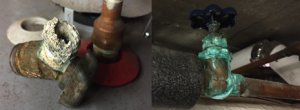Several Important Tips To Make The Tap Water In Your Home Lead-Free
The United States’ water supply has been lined with the poison lead since it was created. And, lead poisoning should be taken very seriously, as it is toxic to every part of the body – adults and children. It can cause problems for the heart, nervous system, and kidneys. And, in children, it can result in permanent neurological damage.
A minute amount of lead can cause a significant number of physical and behavioral problems. However, there is some discussion as to how much is too much for the body. Therefore, it’s important that people do everything they can to reduce how much lead is in their tap water. How can you effectively remove lead from your tap water? It’s important to first look at the lead sources in the water supply.
 From The Treatment Plant To Your Home: Copper Tubing Corrosion
From The Treatment Plant To Your Home: Copper Tubing Corrosion
Water that leaves the treatment plans is usually lead-free. When traveling to your home, it goes through a number of parts that can cause lead to get into the water. The majority of these leaches are from copper tubing corrosion.
In the past, it was a 50/50 kind of solder – 50 percent tin, 50 percent lead. Everything was soldered using the 50/50 method. When it came to soldering, the combination made things easy and ensured solid joints. It heated quicker and cooled slowly than the 1986 introduction of lead-free solders. These kinds of solders demanded people have more skill to use them.
While plumbers knew the reasons for the introduction of lead-free solders, it didn’t mean they liked them… for several reasons:
1 – Increased possibility of leaks because of improper joints
2 – Increased danger of using torch in wall (possible fire issue)
That’s not to say lead-free solder was actually lead-free; it just had a miniscule amount of lead – 0.2 percent. Manufacturers said the minute amount allowed the solder to flow better. While 50/50 solder can be found today, it’s not used in drinking water systems. In fact, electricians and those in the electronics industry like the 50/50 solder.
If your home’s copper tubing was installed before 1986, its joints are soldered with the 50/50, and because of that, the lead will typically get into the water due to corrosion – most especially when the water has a low pH level or the mineral content is low. At this point, it would be best to repipe your home to ensure it doesn’t flood, as older copper can cultivate pinholes.
Thus, the amount of lead in the solder is not the only motive you should replace the copper tubing. If you’re not sure when the copper tubing was installed, have a plumber test the joints for lead content and look at the tubing sections for the integrity.
The fluxes that were used to make the joints for soldering was typically fat-based and had poisons that slowly leaked into the water supply. By 1986, these, along with the lead solders, were no longer used for potable water. However, they were still used on copper draining pipes and could be accidentally or illegally used on potable water systems. Today’s fluxes are water-based, which allows them and the contaminants to get quickly flushed out.
Another hazard are the faucets. Under the previous regulations, faucets could have up to a quarter pound of lead. However, in 2006, California – Maryland and Vermont later – put statutes in place to reduce the faucet lead leaching to nothing. California passed another law that dramatically reduced how much lead leaching was in pipes, fixtures and fittings. 
Before you install any faucet or fixture, learn what the lead content is from the manufacturer. You want as low to nothing as possible. Get the information in writing too, if you can. Faucets manufactured in California must be lead free. Of course, the government does allow for a minute amount of lead.
What To Do If You Can’t Repipe Your Home
So, what do you do if you’re not able to afford repiping and replacing faucets? This is when you invest in a water filtration system that can remove lead and various other metals and treat the tainted water. They will need maintenance every now and then, and if not conducted, can stop working as they should.
Keep in mind that filtered water that goes through a leaded faucet will boost the possibility of lead getting into the water. Use a filtration system to take the lead out so that water you are going to drink doesn’t have any of the metal in it.

Sannitree Fat Trap